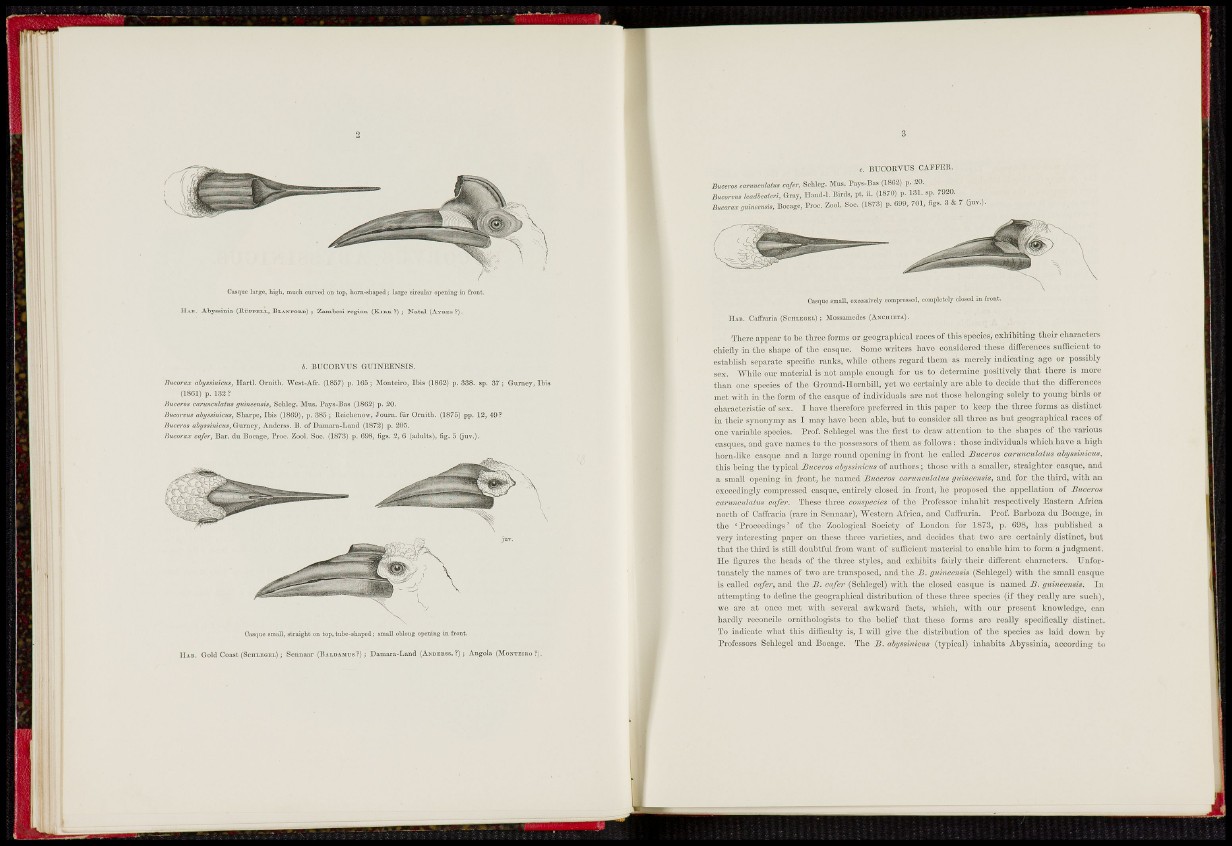
Casque large, high, much curved on top, horn-shaped; large circular opening in front.
IIAB- Abyssinia {RUPPELL, BLANFOKD) ; Zamliesi region (KIIIK ? ) ; Natal (AYIIES ?).
b. BUCORVUS GUINEENSIS.
Ifncorax abyasinicue, Ilartl. Ornith, West-Afr, (1857) p. 165; Monteiro, Ibis (1862) p. 338. sp. 37; Gumcv, ïbis
(1861) p. 132?
liuceros caruncidatus guinemais, Schlcg. Miis. Pays-Bas (1862) p. 20.
Bucorvui ahjssinicm, Sliai-pe, Ibis (1869), p. 385; Reicbeuow, Joum. für Orni th. (1875) pp. 12, 49?
liuceros abi/ssi>ùcus,Gmiicy, Andcrss. 13. of Dam a r a -La n d (1872) p. 205.
Hticorax cafei-, Bar. du Bocage, Proo. Zool. Soc. (1873) p. 698, iigs. 2, 6 (adults), fig. 5 (juv.).
c. BUCORVUS GAFFER.
Buceros carunculatm cafer, Schleg. Mus. Pays-Bas (1862) p. 20.
Bucorvus kadbealm, Gray, IIand-1. Birds, pt, ii. (1870) p. 131. sp. 7920.
B u c a r a x s u i n m Bocage, Proc. Zool. Soc. (1873) p. C99, 701, figs. 3 & 7 (¿uv.).
Casiiue small, straight on top, tube-shaped ; small ohlong opening in front.
TL.^n. Gold Coast (ScnLEGEL); Scnnaar (BALDAMUS?); Damara-Land (ANDERSS.?); Angola (MONTEIRO?).
Casque small, excessively comprcsscd, complotely closed in front.
HAD. Caffraria (SCHLEGEL) ; Mossamedcs (AKCIIIETA).
There appear to be three forms or geographical races of this species, exhibiting their characters
chicily in the shape of tlie casque. Some writers have considered these diiFereiices sufficicmt to
establish separate specific ranks, while others regard them as merely indicating age or possibly
sex. "While our material is not ample enough for us to determine positively that there is more
than one species of tlie Ground-llornbill, yet we certainly ar(i able to decide that the differcnecs
met with in the form of the casque of individuals are not tliose belonging solely to young birds or
characteristic of sex. I have therefore preferred in this paper to keep the three forms as distinct
in their synonymy as I may have been able, but to consider all three as but geographical races of
one variable species. Prof. Schlegcl was the first to draw attention to the shapes of the various
casques, and gave names to the possessors of them as follows : those individuals which have a higli
horn-like casque and a large round opening in front he called Buceros carunculatus abyssinicm,
this being the typical Buceros abysbinicus of authors; those with a smaller, straighter casque, and
a small opening in front, he named Buceros carunculatus guineensis, and for the third, with an
exceedingly comprcsscd casqiie, entirely closed in front, he proposed tlie apjjellation of Buceros
carunculatus eafer. These three conspecies of the Professor inhabit respectively Eastern Africa
north of Caffraria (rare in Scnnaar), Western Africa, and CafTraria. Prof. Barboza du Bocage, in
the ' Proceedings' of the Zoological Society of London for 1873, p. 698, has published a
very interesting paper on these three varieties, and decides that two are certainly distinct, but
that the third is stUl doubtful from want of suiRcient material to enable him to form a judgment,
l i e figures the heads of the three styles, and exhibits fairly their different characters. Unfortunately
the names of two are transposed, and the B. guineensis (Schlegel) with the small casque
is called cafer, and the B. cafer (Schlegel) with the closed casque is named B. guineensis. In
attempting to define the geographical distribution of these tliree species (if they really are such),
we are at once met with several awkward facts, whicli, with our present knowledge, can
hardly reconcile ornithologists to the belief that these forms are really specifically distinct.
To indicate what this difficulty is, I will give the distribution of the species as laid down by
Professors Schlegel and Bocage. The B. abtjssinicus (typical) inhabits Abyssinia, according to